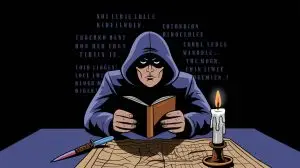“A Charlie Brown Christmas” has become as much a staple of holiday traditions as mistletoe and twinkling lights. When it first graced the screens on December 9, 1965, few could have predicted the enduring impact this animated Christmas special would have. The show’s journey to becoming a classic wasn’t straightforward, and along the way, it broke molds and set standards for what a holiday program could be.

The story, inspired by the simple yet profound narratives that Peanuts creator Charles M. Schulz was known for, explores themes of loneliness, materialism, and the search for the true meaning of Christmas. Narratively centered around a disheartened Charlie Brown navigating the commercialism of the holiday season, the special resonated with audiences through its sincere and poignant storytelling.
Reveling in its quaint animation and a jazz soundtrack that’s become inseparable from the show’s identity, the success of “A Charlie Brown Christmas” kick-started a genre of holiday broadcasting. Its discussion on the commercial nature of Christmas, and the return to the story’s heartfelt roots, set it apart from its contemporaries and worked in surprising ways to bring generations together, creating a beloved holiday tradition that continues to be cherished over half a century later.
Creation and Concept
The inception of “A Charlie Brown Christmas” intertwines the visions of cartoonist Charles Schulz and producer Lee Mendelson, resulting in a timeless holiday classic that unexpectedly challenged the commercialization of Christmas.
Origins and Inspiration
The journey began when Lee Mendelson failed in his initial attempt to create a documentary about the beloved “Peanuts” series and its creator, Charles Schulz. This setback paved the way for what would become a cherished Christmas special. The collaboration’s intent was to produce a meaningful story that reflected the true essence of the holiday season, diverging from the typical commercial approach prevalent in the 1960s.
Charles Schulz’s Involvement
As the creator of “Peanuts,” Charles Schulz was instrumental in the special’s storyline and characters. Schulz insisted on incorporating themes of holiday commercialization and the search for true Christmas spirit, rooted in his own experiences and beliefs. Schulz’s humor and philosophy brought a unique depth to the Christmas narrative, ensuring that it was imbued with sincerity and thoughtfulness.
Development of the Concept
The concept’s development was a collaborative effort that culminated in a script full of wistful charm and a poignant message. Against conventional norms, the team decided to employ actual children to voice the “Peanuts” characters and integrated a jazz score by Vince Guaraldi. These artistic choices, although risky at the time, contributed significantly to the distinct and endearing qualities of “A Charlie Brown Christmas.”
Production Details
In 1965, “A Charlie Brown Christmas” marked a significant moment in animation history, blending the talents of animator Bill Melendez, the innocent voices of child actors, and the memorable jazz soundtrack composed by Vince Guaraldi.
Animation Process
The animation process for “A Charlie Brown Christmas” was a collaborative effort led by Bill Melendez. This early Peanuts animation had to capture the simplicity of Charles Schulz’s comic strips, which presented a unique challenge. This was tackled within a short timeframe, and in an era long before the digitization of animation, every frame had to be hand-drawn and painted, necessitating intense dedication from every animator involved.
Voice Acting and Characters
Character authenticity was achieved through the use of child actors for the voices of the Peanuts gang, an unusual choice at a time when adult actors typically voiced children’s characters. This added a layer of realism and charm to the special, complementing the hand-drawn animation. Notably, the character of Charlie Brown voiced his existential doubts and holiday blues, resonating with audiences of all ages.
Music and Score Composition
The music and score composition by Vince Guaraldi introduced a jazz soundtrack to the world of animated television, which was revolutionary at the time. Guaraldi’s pieces, such as the now-iconic “Linus and Lucy,” added a layer of sophistication and underscored the emotional beats of the narrative, leaving an indelible mark on the sonic landscape of holiday specials.
Initial Reception and Challenges

The debut of A Charlie Brown Christmas faced a healthy dose of skepticism from network executives and diverged significantly from typical holiday specials of the time, creating uncertainty about its success upon initial broadcast.
Network Skepticism
Executives at CBS were not immediately convinced that A Charlie Brown Christmas would resonate with viewers. The simplicity of the animation and the reliance on child voice actors—uncommon practices at the time—sparked doubts about the special’s potential appeal. The use of Vince Guaraldi’s jazz score was another element that deviated from expectations, as holiday specials traditionally employed a more standard festive soundtrack.
Risks and Innovations
The Peanuts Comic Strip had established a beloved cast of characters, but bringing them into a television holiday special involved significant risks. Producer Lee Mendelson and animator Bill Melendez took creative gambles, such as insisting on a script without a laugh track, aiming for a more authentic and heartfelt presentation. Moreover, the inclusion of a poignant recitation from the Bible further set it apart, being a bold choice for a holiday special on public television.
Initial Broadcast
When CBS first aired the special on December 9, 1965, the network braced for a possible flop. However, the anxieties of television executives proved unfounded as half of the TVs in America tuned in. The initial broadcast was not only a ratings triumph but also went on to win both an Emmy and a Peabody award, securing its place as a cherished holiday tradition.
Cultural Impact
Since its debut, “A Charlie Brown Christmas” has left an indelible mark on the entertainment industry, shaping how viewers appreciate holiday specials and influencing creative choices in television and film.
Influencing Television and Film
“It’s hard to remember a time when A Charlie Brown Christmas wasn’t a part of the cultural fabric of this country,” remarks a Town & Country Magazine article. The television special not only won both an Emmy and a Peabody Award, acknowledging its excellence in television, but it also set a precedent for future holiday programming. When “A Charlie Brown Christmas” first aired, shows like “The Munsters” and “Bonanza” dominated the TV landscape. The introduction of an animated, holiday-themed special with a poignant message and jazzy score was a contrast to prevailing TV offerings and has since inspired creators to explore meaningful content in holiday specials.
Significance in Popular Culture
“A Charlie Brown Christmas” has secured a perennial spot in America’s holiday season traditions. The animated special has become a cornerstone of holiday viewing, akin to a ritual that ushers in the festive spirit. It not only impacted other holiday specials but also permeated pop culture, with its memorable quotes and scenes becoming iconic. Beyond television, its influence is seen in advertising as the characters from the special are often used in holiday campaigns, proving the special’s lasting appeal and recognizability. The memorable soundtrack continues to resonate, making it as much a herald of the season as the story itself.
Themes and Messages

In “A Charlie Brown Christmas,” the core themes revolve around the true meaning of Christmas beyond its commercial aspects, incorporating religious elements and questioning the consumerism that can overshadow the holiday’s essence.
Religious Elements
The religious undertones of “A Charlie Brown Christmas” are most poignantly expressed through Linus. During the Christmas Pageant, he recites from the Gospel of Luke, specifically Luke 2, sharing the biblical story of Christ’s birth. This moment stands out as the pivot point of the narrative, redirecting attention from the festive trappings back to the holiday’s spiritual roots.
Critique of Commercialization
The special is also notable for its critique of excessive commercialization. Charlie Brown’s dismay at the rampant consumerism surrounding Christmas reflects a concern with society’s focus on materialism and commercialization. Through his quest to find the true meaning of Christmas assisted by his friends, viewers are reminded that the holiday should not be overshadowed by consumerism.
Legacy and Influence
“A Charlie Brown Christmas” has become an enduring piece of holiday media with a significant impact on popular culture, showcasing the timeless nature of its message and its creator, Charles Schulz. Its influence is seen in various domains, from its annual broadcasts to the diverse range of merchandise it has inspired.
Subsequent Airings and Remastering
Initially broadcast on CBS and later finding its home on ABC, “A Charlie Brown Christmas” has had annual airings since its debut in 1965, becoming a festive tradition for families across the nation. The transition of this animated cartoon from standard definition to high definition required meticulous remastering. Disney, subsequently acquiring the rights, has continued this practice, ensuring that the visual and audio quality meets modern standards, thus preserving Schulz’s original vision for new generations to enjoy.
Merchandising and Adaptations
Over the decades, the influence of “A Charlie Brown Christmas” has extended into the realm of merchandising, with an array of products from toys to clothing capturing the hearts of both young and old. The RIAA has recognized the popularity of the special’s soundtrack, which continues to be a fixture of holiday music playlists. Adaptations have been many, including theatrical productions licensed by Tams-Witmark, indicating the special’s capacity to transcend the small screen and enter the hearts of audiences through live performances. The success of the animated cartoon has shown the enduring relevance of Schulz’s work and its ability to resonate with diverse audiences through multiple formats.
Trivia and Interesting Facts
The story behind “A Charlie Brown Christmas” is filled with unexpected tidbits and milestones that made the TV special a beloved holiday classic. From the production struggles to the warm reception and the secret nuggets carefully placed within the narrative, each fact contributes to the magic that has enchanted viewers for decades.
Production Anecdotes
Willie Mays and the Unlikely Pitch
The idea for “A Charlie Brown Christmas” originally sprang from a documentary that was never made about the legendary baseball player Willie Mays. The producer, Lee Mendelson, decided to pivot the focus towards Charles Schulz’s Peanuts characters, ultimately leading to the creation of the holiday special.
McCann-Erickson’s Role
The famous advertising agency McCann-Erickson played an instrumental role in breathing life into “A Charlie Brown Christmas.” It was because of their involvement that the special received sponsorship and financial support, ensuring the vision became a televised reality.
Reception Milestones
TV Guide and Cultural Impact
After its initial broadcast, “A Charlie Brown Christmas” was an instant success, capturing the hearts of audiences and critics alike. It has since become a holiday staple, recognized by TV Guide as one of the top ten holiday specials.
Grammy Recognition and Jazz Influence
The soundtrack, arranged by Vince Guaraldi, introduced jazz to many homes for the first time. Its influence was profound, leading to jazz pianist David Benoit reviving the music through his own interpretations and performances, which paid homage to the original score.
Hidden Details
Ice Skating Charm
The opening scene, where the characters are ice skating, was inspired by a Coca-Cola commercial. The serene moment harmonizes with the graceful ‘Christmas Time is Here,’ setting the tone for the rest of the special.
Christmas Carols and Lucy Van Pelt’s Demands
The inclusion of traditional Christmas Carols was initially controversial, but Charles Schulz insisted on their presence. Meanwhile, Lucy Van Pelt’s character requests real estate in her letter to Santa, a humorous detail suggesting her precocious nature.
Steve is the creative force behind My Unique Tales, a blog dedicated to sharing captivating stories that explore the human experience in all its complexity. With a passion for writing and a talent for crafting engaging narratives, Steve's blog is a treasure trove of imaginative tales that transport readers to other worlds and challenge them to see things from new perspectives. From epic adventures to intimate character studies, Steve's stories are always thought-provoking and emotionally resonant. With a growing following of readers who appreciate his unique voice and creative vision, Steve is quickly becoming a rising star in the world of online storytelling.






